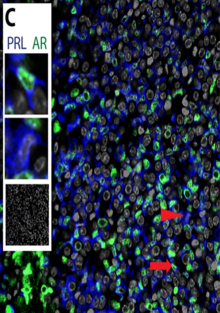|
Prolactin cell
A prolactin cell (also known as a lactotropic cell, epsilon acidophil, lactotrope, lactotroph, mammatroph, mammotroph) is a cell in the anterior pituitary which produces prolactin (a peptide hormone) in response to hormonal signals including dopamine (which is inhibitory), thyrotropin-releasing hormone and estrogen (especially during pregnancy), which are stimulatory. Prolactin is responsible for actions needed for body homeostasis, the development of breasts, and for lactation.[1] The inhibitory effects of dopamine override the stimulatory effects of TRH in non-pregnant, non-lactating sexually mature females. Depending on the sex of the individual, prolactin cells account for 20% - 50% of all cells in the anterior pituitary gland.[2] The inhibitory effects of dopamine override the stimulatory effects of TRH in non-pregnant, non-lactating sexually mature females.[1] Other regulators include oxytocin and progesterone.[citation needed] Males and non-pregnant, non-lactating females typically have low levels of prolactin.[1] The number for prolactin cells in a pregnant female will increase to allow for breast tissue development. Prolactin is involved in the maturation of mammary glands and their secretion of milk in association with oxytocin, estrogen, progesterone, glucocorticoids, and others. Prolactin has numerous other effects in both sexes.[citation needed] FunctionWhen prolactin cells are observed in vitro, they are responsible for firing spontaneous action potentials, causing Ca2+ to follow the action potential pathway and allows for the exocytotic pathway, prolactin gene transcription, and hormone synthesis to remain active throughout.[2] Prolactin gene transcription is responsible for the production of prolactin. Prolactin is involved in the maturation of mammary glands and their secretion of milk in association with oxytocin, estrogen, progesterone, glucocorticoids, and others. Prolactin has numerous other effects in both sexes.[3] ConditionsProlactin cells are acidophilic by hematoxylin & eosin stains and, If these cells undergo neoplastic transformation, they will give rise to a prolactinoma, a prolactin-secreting pituitary adenoma.[3] Prolactinoma is a tumor of the pituitary gland that is typically non-cancerous. This disorder is more common in females than males. Although the tumor itself may not cause symptoms, the tumor can cause an increased production of prolactin and decreased levels of estrogen and testosterone.[3] Symptoms of both sexes could include osteoporosis, infertility, or a decrease in sexual desire.  In men, prolactinoma could also cause erectile dysfunction, enlarged breast tissue, small muscles or a decrease in the amount of body hair. In women, this could cause breast discharge, irregular menstrual cycles, painful intercourse, acne, or an increase in the amount of body hair. See alsoReferences
|
||||||||||||||||||||